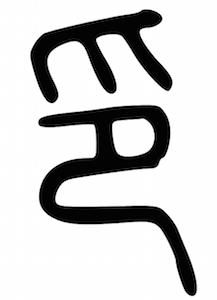The “seal” radical 卩 serves up one disappointment. The “seal” in question is not a whiskered marine mammal!
Actually, it’s hard to know where the English radical name “seal” originated. There is an autonomous 卩 character read as セツ, but this two-stroke non-Joyo kanji represents “sign, symbol, tally,” not “seal.”
As I’ll explain, the radical name may relate to 印 (425: to imprint; seal; mark, sign, symbol; India). That’s the best I can say for sure. Uncertainty swirls around this simple-looking radical that reminds me of a shepherd’s hook. That would have been a better radical name!
What Is the 卩 Radical Called in Japanese?
The 卩 radical goes by three Japanese names:
1. ふしづくり
Rendered in kanji as 節旁, the name ふしづくり means “‘seal’ radical on the right side.” Five Joyo kanji feature an on-duty 卩 radical on the right:
印 (425: to imprint; seal; mark, sign, symbol; India)
卵 (990: egg)
卸 (1042: wholesale; to grate; filleting fish)
却 (1145: to eliminate; reject, return; all the more)
即 (1534: immediate; that is)
As it says in “Radical Terms” in the discussion of Position 2, a right-side radical is called -旁 (-つくり: side), so the -旁 in the radical name is quite clear, but what of the 節? You might assume 節 meant “seal,” but this kanji instead represents many other things, including “bamboo tally used in ancient China,” which seems more pertinent to the next radical name. Ultimately, I’m not sure why 節旁 includes 節 except that that character features a 卩 on the lower right, making it a decent example of where to find the radical. I think, though, that any kanji with an on-duty 卩 radical would have served as a better example; 節 belongs under 竹, the “bamboo” radical.
2. わりふ
The radical name わりふ, rendered in kanji as 割符, means “tally; check; piece of wood or bamboo split in half and given to each party as a form of proof (e.g., of a transaction).” It’s hard to say how any of that connects to 卩.
3. まげわりふ
In the name まげわりふ, the まげ (曲げ) means “bent” or “crooked.” A bent or crooked version of 卩 is the variant form 㔾, as in this kanji:
危 (831: danger; fear; uncertain; nearly)
Now we’ve seen not only all the radical names but also each of the six Joyo kanji featuring an on-duty “seal” radical.
Not Seal but Kneel
I believe the “seal” definition of 印 (425: to imprint; seal; mark, sign, symbol; India) gave rise to the English name “seal” for the 卩 radical. This is just a hunch (one my proofreader shares), but the idea would be that 卩 is the radical found in 印, which can mean “seal.”
I was therefore eager to examine the etymology of 印, hoping to understand more about the seal connection. I learned instead that the 卩 in that character means “kneel,” not “seal.” More specifically, Henshall says in his newer edition that the radical in 印 symbolizes “kneeling person.” Here is his analysis:
印 (425: to imprint; seal; mark, sign, symbol; India)
An older form shows a “hand pressing down on a kneeling person,” yielding “press someone down from above and make kneel/submit.” The meaning “press” gave rise to extended usages such as “(name) seal” and “printing.”
Sears displays the older form of 印 on his page:

In fact, this is the seal-script version. Ah, finally a seal connection—but not a relevant or useful one! The top half represents the “hand pressing down” to which Henshall alluded, whereas the bottom half symbolizes “kneeling person.” Note that the 卩 in this old shape has rotated 90 degrees, as if it has keeled over, so in a sense we’re seeing “keel” along with “kneel”!
More Etymologies
Etymologically, 印 is not an oddball. In four more kanji in which 卩 is on duty, this radical again means “kneeling person.” Here are Henshall’s explanations:
危 (831: danger; fear; uncertain; nearly)
The ク and 厂 collectively depict a “person kneeling or squatting down fearfully on top of a cliff or roof.” The 㔾 (added later) also means “kneel/bend.” The whole character therefore represents “kneel/crouch down fearfully on top of a cliff/roof,” with “dangerous” and “afraid” as extended senses.
卸 (1042: wholesale; to grate; filleting fish)
The entire character may depict a person kneeling (卩) before a device as part of a ritual to expel demons! The 止 on the lower left could emphasize movement in the act of expelling. One researcher views “wholesale” as an extended sense. Another scholar sees the radical as symbolizing “submissive person” and advances a theory involving a pestle, a confined slave, and a horse groom. That sounds like quite a story! There’s no mention of fish (filleted or otherwise) in the etymology.
却 (1145: to eliminate; reject, return; all the more)
Originally, the radical meant “person kneeling.” The phonetic had the associated sense “retreat, withdraw,” so the early version of 却 meant “withdraw on one’s knees (from presence of a superior).” That became just “withdraw.”
即 (1534: immediate; that is)
An ancestral form has the radical as “person kneeling” and the left side as “millet (or something similar) piled up in receptacle.” Together these parts meant “come in front of millet or other food/be about to eat.”
Speaking of food, I’ve been most curious about the role of our radical in this character:
卵 (990: egg)
But it turns out that 卵 has nothing to do with a seal. Instead, the whole character is a pictograph. Depending on which scholar you ask, says Henshall, the character represents “frog spawn,” “fish eggs,” “insect eggs,” or even “treadles on a loom”!